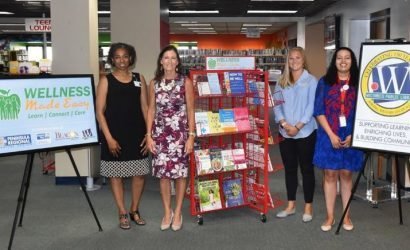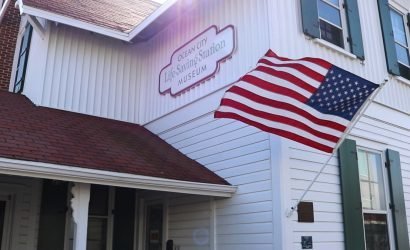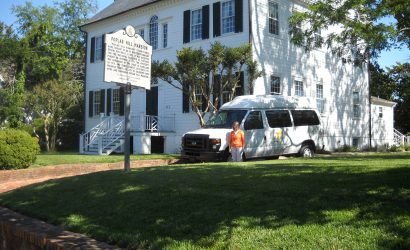November is Native American History Month. The Eastern Shore is one of the oldest areas in the country in terms of English settlements. Long before these settlers ever visited our shores, Native American tribes flourished here. Do you know the tribes that once called these lands home? Read on to find out the true history of the people of the Eastern Shore…
We all know the famous and true story of Pocahontas—devastatingly beautiful Indian princess who saved the dashing Captain John Smith from beheading, after her father, emperor of the Indian lands, imprisoned him—or do we?
As Professor Ray Thompson, Director of the Nabb Research Facility at Salisbury University pointed out, we often piece together this story initially from the Disney-fied or romanticized versions, the overlays we have been exposed to as part of our culture. But before Disney ever put their spin on things, it may have been Captain John Smith who initially told a false-truth, weaving a fictional account that would withstand the tests of time unfortunately far better than the very people it was written about.
The absolute truth about Pocahontas is that she was the daughter of Powhatan, who was Chieftain of a Confederacy of Tribes stretching from the northeastern shores of North Carolina, covering the coastal areas of Virginia and Maryland, and ending north in Sussex County, DE. Meaning that once upon a time, at least as long ago as 1607, the infamous Pocahontas was a princess of sorts over our region.
It’s possible that she visited this coastal area, though not likely, as she was very young, and lived on the banks of the James River, on the western shore of the Chesapeake near Jamestown, Virginia. The fact that she was very young when the account took place indicates the largest and most obvious hole in the romantic story. John Smith was captured by Powhatan, and eventually released, but not likely thanks to Pocahontas falling madly in love with him, as she was around twelve years old at the time. It is however well documented that Smith and Pocahontas did become friends, meeting again years later in England, one final time.
We owe the story of Pocahontas to Captain John Smith’s logbooks, though not his initial version. The first run of what Smith told as his experiences in the new world made no mention of the young Indian princess. She wouldn’t show up until later volumes of the work, more embellished accounts of what really transpired either after Smith turned from explorer to novelist, or simply just decided to add in more details after his stories became popular—the truth is really anybody’s guess.
The Native People of the Eastern Shore, As Told By…
These same logbooks are what we also credit as the first accounts of the Native American people who once lived in our coastal region. The Nabb Research Center at Salisbury University held an exhibit beginning with the year 1608, what they refer to as the "First Contact," when Captain John Smith met the Native American people of the Chesapeake Bay region and the Eastern Shore, making him the first English speaking person to create a written account of our region.
The Center’s exhibit brought together three groups of information: the written first-person narratives of John Smith and others, the watercolors of John White, who accompanied Sir Walter Raleigh on his quest in 1585 to settle “Virginia,” and actual artifacts from the time period. Many of the pieces were pottery, specifically known as Townsend Ware, resurrected from the site at Handsell House near Vienna, once a notable Indian village. Of the three types of information, the artifacts are the most accurate, as they were the actual tools used by the Native Americans. White’s drawings are second, as it’s assumed he painted what he saw with little interpretation. Last then are the written records, and according to Dr. Thompson, are the least accurate.
“These original documents are skewed because we are looking at the lives of the Native Americans through the eyes of the Europeans who didn’t really understand what they saw,” expliained Thompson.
We do know, based on Captain John Smith’s logbooks and maps that he explored in-depth not only the Chesapeake Bay region and the Virginia shore, but also the Pocomoke, the Nanticoke, and the Choptank Rivers, encountering the Native Americans who lived along their banks.
Native American Way of Life
In the 17th century the Native Americans of the Eastern Shore were very matriarchal society, and women did most of the planting and gathering, which included mainly corn, beans, and squash. They prepared other foods like smoked fish, shellfish, ground nuts, corn and Tuckahoe tubers for baking bread. They made meals out of rabbit, beaver, deer, squirrels, birds, and even woodchucks.
Homes were not teepees, as modern beliefs may suppose, but were actually lodges with rounded roofs and frames made of branches. A personal account from Henry Norwood in A Voyage to Virginia dated from 1649, describes the home of a King, made from the same materials as other more typical lodges,
“The King’s mansion…was made of mat and reed. Locust posts sunk in the ground…was the strength of the whole fabric. The roof was tiled tight with rushes…the only furniture was several platforms for lodging. The space in the middle was a chimney, which had a hole in the roof to receive smoke.”
Despite the differences in lifestyle from the Europeans, it was the Native American belief system regarding land that would prove to create the greatest divide amongst the two groups. According to Dr. Thompson,
“Europeans believed in ownership. This differed vastly from the Indians, who believed, in modern terms, as not even make a 'carbon footprint.'”
The Quest for Land
From the time Captain John Smith first made contact and encountered Powhatan, relations between the Europeans and the Indians went through alternating periods of peace and upheaval. Initially, the colonists relied heavily on the Indians for food when they began to make settlements—as was the case in Jamestown, VA, and the more famous story of the Pilgrims and the Indians in Plymouth, MA.
Land on the Eastern Shore, with the exception of Virginia, wasn’t a point of contention until the mid 1600’s. In 1632 Lord Baltimore was granted a charter for Maryland, in order to colonize the land. This action played a large part in the destruction of the Native American way of life. Up until this point, the only interaction between the coastal tribes and the English involved the fur trade. In 1642 Maryland’s newly formed colonial government declared war on three tribes, the Wicomiss, Susquhannocks and the Nanticokes, as a result of the murder of an Englishman involved in fur trading. The colonial government was ignorant to the fact that these three tribes were foreign to each other; they didn’t even speak the same language, and were wrongfully aligned together. By the 1660’s the fur trade was in decline, severing the final peacemaking link between the Indians and the colonists.
The push to colonize the land spread east. English settlers didn’t understand, or didn’t respect Indian ownership, and believed Lord Baltimore had the rights to assign lands, often out from under the Native Americans. Dwindling relations within the Indian tribes further complicated the matter, and the scope of the land was drastically altered.
Indian Towns, and where are they now?
In 1668 the main tribes of the Eastern Shore were the Wicomiss, Choptanks, Nanticokes, and the Pocomokes and Assateagues. The Wicomiss lived near Chicone, situated close to the modern town of Vienna. The Choptanks occupied the South Side of the Choptank River around what is now Cambridge. The Nanticoke, the largest tribe, were located on the Nanticoke River, and controlled an area south to the Wicomico River. The Manokin resided near modern-day Princess Anne, and the Pocomoke had lands from lower Somerset County, MD into Accomack County, VA.
By 1678 the two largest Indian towns remaining were Askiminikansen on the Pocomoke River, near modern day Snow Hill, and Chicone, on the Nanticoke River by Vienna. Towards the end of the 1600’s, Indian tribes, depending upon their loyalties, often aligned with other tribes, disbanding their own towns, often in fear of the Five Nations of the Iroquois. Others moved north, joining tribes in Pennsylvania, and those remaining ended up on reservations, forced by various proclamations and colonial law from the very lands they once revered. By 1800, there were no reservations left.
The Final Outcome, and the Return of Pocahontas
The devastation of the Indian Tribes on the Eastern Shore was only in part due to fighting and colonization. The largest factor in destruction was the unseen threat the English brought with them in the form of viruses – small pox, measles, influenza and whooping cough as the main culprits, killed an alarming number of Indians. They had no natural or acquired immunity to these diseases. As it turns out, humans share many diseases with livestock—as many as 50 with cattle, and 42 with pigs, for example, and since the Indians had not domesticated their animals, they were not exposed to many diseases until the colonists brought them from Europe, and decimated the tribes.
Thomas Harriot, writing from A Brief and True Report of the New Found Land of Virginia in 1590 said,
“There was no towne…which we left…but that within a few days after our departure from every such towne, the people began to die very fast, and many in short space, in some towns about twentie, in some fourtie, in some sixtie…which in truth was very manie (many) in respect to their numbers.”
The native priests and chieftains didn’t know how to fight against what was killing off their tribes. And as for the colonists, they largely and incorrectly assumed it was a matter of religion—they themselves not realizing they were carrying disease, these death waves had to be a result of the hand of God.
The topic of disease brings us back to Pocahontas, the romanticized heroine from the beginning of our story. Regardless of the truth of the famous John Smith account, Pocahontas did go on to play an integral part in relations between the colonists and her native people. It was her marriage to colonist John Rolfe in 1614 that brought about a period of peace. In 1617 she went to England with her husband, and supposedly saw once more, her old friend John Smith. While getting ready for the return trip to Virginia, Pocahontas fell ill, and never made it home. She had become a victim of disease, like many of her native people from the Eastern Shore, dying as a result of either tuberculosis or pneumonia at the young age of 22. She is buried in England.
Modern Day Traces
Today, The Nabb Center in Salisbury has a great number of artifacts gathered from area farms. But for an area once covered with towns and camps of native people, there should be more evidence. Dr. Thompson explained,
“As the land was taken over by farmers, there would be artifacts and pottery that would be tilled up, and they thought nothing of it. It wasn’t until the mid twentieth century that people began paying attention to what had happened.”
In 2003 construction work near Pemberton Park in Salisbury unearthed an ossuary, or group burial site with the remains of approximately 35 Native Americans dating back to 1400. As for actual sites of former towns, nothing remains at Askiminikansen near Snow Hill. Chicone, near Vienna fares much better. It was the former site of the home of a chieftain and large Indian village, and later was called Handsell Mansion house. Many pieces of pottery and artifacts including axe heads and arrowheads have been recovered from this site. Handsell is in the process of becoming a public facility.
“It will be a facility dedicated to Native Americans, African Americans, and English settlers—the three groups who lived there at various stages of occupation,” said Dr. Thompson.
Additionally, the Nanticoke tribe runs the Nanticoke Indian Museum in Millsboro, DE. They have done considerable work to preserve their heritage.
We thank Dr. Ray Thompson and the Nabb Research Center at Salisbury University for sharing their records and extensive research, and helping us to tell the story of the Native Americans of the Eastern Shore.
You can visit The Nabb Research Center at Salisbury University, find more information here.
Or the Nanticoke Indian Museum here.









